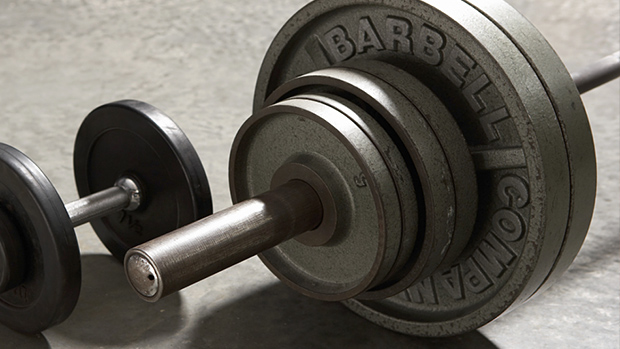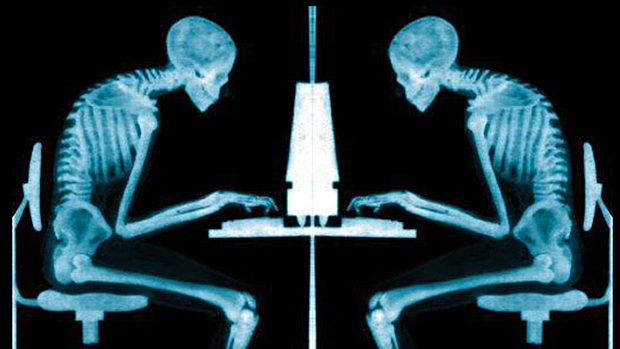"Chaos" is an intimidating name for a training method. But all it means is adding instability to traditional barbell lifts, core movements, or weighted carries. The chaos part is just a metaphor for what it feels like when you're trying to hold an unstable bar steady.
You could use a bamboo bar or Earthquake Bar for this, but they aren't necessary. A normal barbell, plates or kettlebells, and a couple of bands will work fine.
Regardless of what lift you're doing, the chaos method will challenge every fiber of your being and activate primary muscles like the glutes, traps, hips, abs, and all the spinal musculature you need for a strong, healthy trunk and back.
Chaos training also strengthens and builds the smaller stabilizer muscles, tendons, and ligaments of specific joints. Take the overhead press for example.
The chaotic nature of the bar will force the smaller muscles of the shoulders and upper back to come alive as you fight to avoid dropping the bar on your head. This causes you to use muscles which are often neglected, strengthening your weak points.
This type of training can make much lighter loads cause more stress and increase difficulty without loading excessive weight. This builds up your weak points and simultaneously increases your lifting longevity rather than continuously breaking you down.
When you put a bar overhead, you'll discover the importance of anti-trunk movements. You'll be forced to hold and maintain anti-flexion, anti-extension, anti-rotation, and anti-lateral flexion while holding the bar steady and fighting the chaos.
This type of work is paramount because any time you're doing a major compound lift – like the bench press, squat, or deadlift – you're bracing the core in a similar way.
Carries are great for improving work capacity, grip, upper back, and even trunk strength. These are best used to finish a workout. Do these 2-4 times for 60-90 seconds or 2-4 times for 20-100 yards. (While you could do them using maximal weight, that isn't the safest way to go, nor is it necessary.)
Barbell Chaotic Zercher Carry
Barbell Chaotic Overhead Carry
Hex Bar Chaotic Farmer's Walk
Hex Bar Chaotic Overhead Carry
Kettlebell or Plate Chaotic Farmer's Walk
Here are some alternatives with a specialty bar...
Bamboo Bar Chaotic Zercher Carry
Bamboo Bar Chaotic Overhead Carry
Isometrics are underrated and underused. Why? Probably because they're hard and boring. And you never hear someone brag about how long they can isometrically hold a bodyweight position... although they should!
Adding the chaos method to isometrics should only be done once you're proficient in basic isometric holds. If you can barely hold a push-up plank or bodyweight split squat, don't add a bar with weight hanging off it.
Chaotic isometrics are great at the beginning of a workout, either throughout the warm-up or directly before the main lift itself. Holding the isometric at a specific joint angle can help increase the strength in that position, but also prime the body for the specific action to come.
Example: Doing a chaotic isometric hold at a direct sticking point on the bench press. Just holding the bar a few inches above the chest for as little as 10 seconds can lead to tremendous carryover the next time you're pressing through that sticking point.
Bamboo Bar Bench Press Isometric Hold
Bamboo Bar Overhead Press Isometric Hold
Bamboo Bar Split Squat Isometric Hold
Do these 2-4 times for 10-30 seconds.
The true job of the trunk and spine is to prevent movement. As a lifter, you'll get a lot out of anti-movements of our trunk: anti-flexion, anti-extension, anti-rotation, and anti-lateral flexion.
When doing a heavy back squat, the trunk is stabilizing and internally fights to keep us from folding like a cheap lawn chair. When your in-laws call you to move a heavy couch out of their basement, it's your trunk stabilizing and preventing you from going into lateral flexion and dropping it.
Do these whenever you typically do your core/ab work. Some like to do it first thing in the workout, some do it last. Either is fine.
If you can easily hold one of these for 30 seconds or more, you may need a heavier band or more chaos to raise the difficulty of the movement.
Band Pallof Press and Isometric Hold
Chaotic Band Pallof Isometric Hold
Chaotic Band Plank
Chaotic Band Back Extension Isometric Hold
Do these 2-4 times for 10-30 seconds.
Not much needs to change when substituting your typical accessory movements for chaos movements. You can use the same reps, etc.
Add chaotic accessory movements when you want to work on specific weak points, raise the complexity of a lift you've mastered, or when you just need a change.
Make sure to adjust the tempo of the lift. The speed does make a difference and it's a factor when training for specific adaptations. When working on bringing up those weak points, it's best to use a slow, steady tempo, like two or three seconds for each phase of the lift.
Bench Press
Overhead Press
Bicep Curl
Shrugs
Triceps Extension
Zercher Step-Up
Zercher Reverse Lunge
T Nation earns from qualifying purchases as an Amazon Associate. Read more about our policy.





